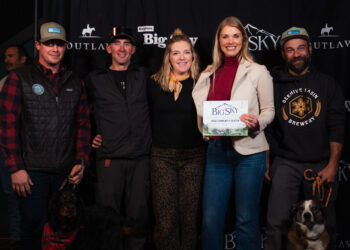By Todd Wilkinson EBS Contributor

Many people, for good reason, have skepticism about marketing and advertising, believing it is only about profit. But I’d like to share an example from the intersection of commerce, social consciousness and improving the quality of human life.
How can companies do the right thing in a way that still bolsters their bottom line?
Consider this story about Valspar, a company that makes house paint. Ace Hardware carries it and so do many home improvement outlets. The story here could serve as a case study for any business wishing to be held in higher esteem by its customers.
We all know it’s triumphant to be transcendent in advertising—to transcend target segments in ways that build the brand and bottom line. It’s something wonderfully more when transcendence means actually opening the eyes of the world, in a social equity sense, enabling people to experience the full richness of earthly beauty for the first time.
You think I’m speaking in platitudes? Stay with me. This too is a tale that holds relevance for the conservation movement in Greater Yellowstone struggling with how to make ideas of landscape protection palpable and inspirational.
The short answer is that environmental groups of all stripes need to do a better job of opening peoples’ eyes, especially those who suffer from nature deficit disorder to the big picture. Again, trust me, there is a tie-in here.
A year ago, paint company Valspar won numerous awards for a campaign it devised titled “Color For The Colorblind,” that used the services of ad agency FCB Chicago and cross branding with EnChroma, a technology company that designs special-purpose eyewear.
Fierce competition exists in the house paint business. VaLspar sought to differentiate itself in the marketplace and leverage its profile against much larger house-paint heavyweights.
“Our conversation started with a simple objective: To help Valspar meet its desire to elevate its brand visibility and better connect with consumers,” Scot Havrilla, FCB’s senior vice president and group management director, told me.
“We knew we couldn’t achieve our goal by doing something that was off the cuff. We needed to set Vaspar apart,” Havrilla said. “The idea behind the campaign started with great insights. Color is a powerful force in influencing human lives and offers all these great benefits we take for granted, especially if we can’t see them.”
Research led the creative team to a discovery. The medical condition known as Color Vision Deficiency (or more commonly “color blindness”) affects a surprisingly large number of people—some 300 million worldwide. One in 12 men have it and one in 20 women. Those afflicted with CVD lack pigments in certain nerve cells of the eye that sense color, preventing them from being able to distinguish different hues and sometimes to see colors only as gray.
“None of us in the beginning had any idea how prolific colorblindness was—300 million people!” said Joel Wasserman, Valspar’s director of brand integration.
“It’s a stat I never thought about,” Wasserman added. “People who are colorblind even joke about it themselves yet many told us they often felt alone and isolated. Meeting them on their terms became fertile ground for crafting a narrative. It turned out to be an emotional experience for them, for us, and for the millions of people we engaged with the campaign.”
As part of their research, Valspar and FCB learned that EnChroma engineered glasses that can correct color blindness using special lenses, a potent cross-branding partnership was born. “We reached out to EnChroma and said if you can bring the glasses to the table, we’ll bring color to the collaboration and partner up,” Havrilla said.
In “Color For The Colorblind,” FCB invited a number of colorblind individuals to rooms holding blazing spectrums of colors they literally could not see. They did it to provide a poignant illustration of how seeing color can be a life-changing revelation.
Those afflicted with colorblindness were filmed trying on a set of EnChroma glasses without being told what the glasses were designed to do. Their stunned, sometimes tear-filled reactions to seeing colors for the first time simply and powerfully conveys this life-changing moment. It is also subtly analogous to the sensation one feels when walking into a freshly painted room.
The campaign, featuring a short video, was rolled out in March 2015. “Color for the Colorblind” became a sensation, notching 800 million social media impressions in the first month alone.
More than 1500 viewers shared video content. In all, some 5.9 million views were on Facebook, Twitter, websites created for Valspar and EnChroma and a microsite, valsparcolorforall.com.
“Through this campaign, we created the first ‘colorblind community’ and it was one that did not exist before,” Tina Manikas, FCB president, said in an interview.
Pivotal to the success, Wasserman says, was communicating a message that identified a little-known problem, addressing it in a provocative, heart-gripping way that cemented a deeper emotional connection with viewers, and then offering a solution which, with EnChroma’s glasses, actually represents a cure.
By conscious design, the campaign kept Valspar’s presence low-key, invoking the brand name only where absolutely appropriate. “Joel was adamant. He said, ‘We can’t just splash the brand all over this thing. It is about making color available for the colorblind, not simply about doing a paint commercial,’” Havrilla says.
“We wanted the brand to be secondary and let the story be the story,” Wasserman said. “This is one of those rare opportunities that, from a marketing standpoint, you’re able to make a huge difference and have impact in a pure brand play. It was done for all the right reasons, not to overtly sell a product, and the fact that Valspar received credit is icing on the cake.”
“Color for the Colorblind” also resonated among some as a powerful metaphor for how a turbulent world—wracked by divisiveness, violence and myopic intolerance—needs to open its eyes to embrace the vibrant promise of diversity. Color blindness too can be used as an analogy for people whom, for whatever reason, cannot see the value of having a connection to nature.
Even more important than the number of views and traffic is the increase in social sentiment associated with Valspar, achieving a favorable rating of 94 percent. The upshot is that more paint consumers will visualize Valspar’s name the next time they go to the paint or hardware store.
Havrilla says the intangible worth of “Color for the Colorblind” is that it is, no pun intended, evergreen as an ongoing vehicle for promoting social consciousness while quietly re-enforcing the Valspar brand.
“In addition to this campaign being the right thing to do and the good thing to do, it fit with the brand and its personality,” Havrilla said.
“Color for the Colorblind” won several major awards, including one from the Association of National Advertisers. “It’s meaningful, purposeful content like this that makes you feel, think and do—and that’s why this campaign was so successful. It speaks to a truth and it is transcendent beyond its budget,” FCB’s Manikas said.
“People gravitate toward a brand that offers a purpose and gives back to the world. Social responsibility is that much strong when it’s reinforced by clarity in which the brand stands for. ‘Color for all’ is something that everyone can understand.’”
Wasserman says he has received notes from Valspar employees telling him they were proud to be working for the company. “To see that kind of response from employees within our own ranks was something I didn’t expect,” he said.
Indeed, the campaign has been a catalyst for Valspar’s brand builders and the company internally embracing a more purposeful and confident identity. “Everything that we work on is about making change for the better. That’s our mission going forward,” Wasserman said. “It is a perfect articulation of what we truly believe.”
Todd Wilkinson has been a journalist for 30 years. He is author of the recent award-winning book “Grizzlies of Pilgrim Creek: An Intimate Portrait of 399, the Most Famous Bear of Greater Yellowstone,” featuring 150 astounding images by renowned American nature photographer Thomas Mangelsen. His article, “2067: The Clock Struck Thirteen,” appears in the winter 2017 edition of Mountain Outlaw magazine, on shelves now. EBS publishes Wilkinson’s New West column every week online and twice a month in the printer version of the paper, under a partnership arrangement with the Wyoming online journal thebullseye.media. We encourage you to check out The Bullseye.














